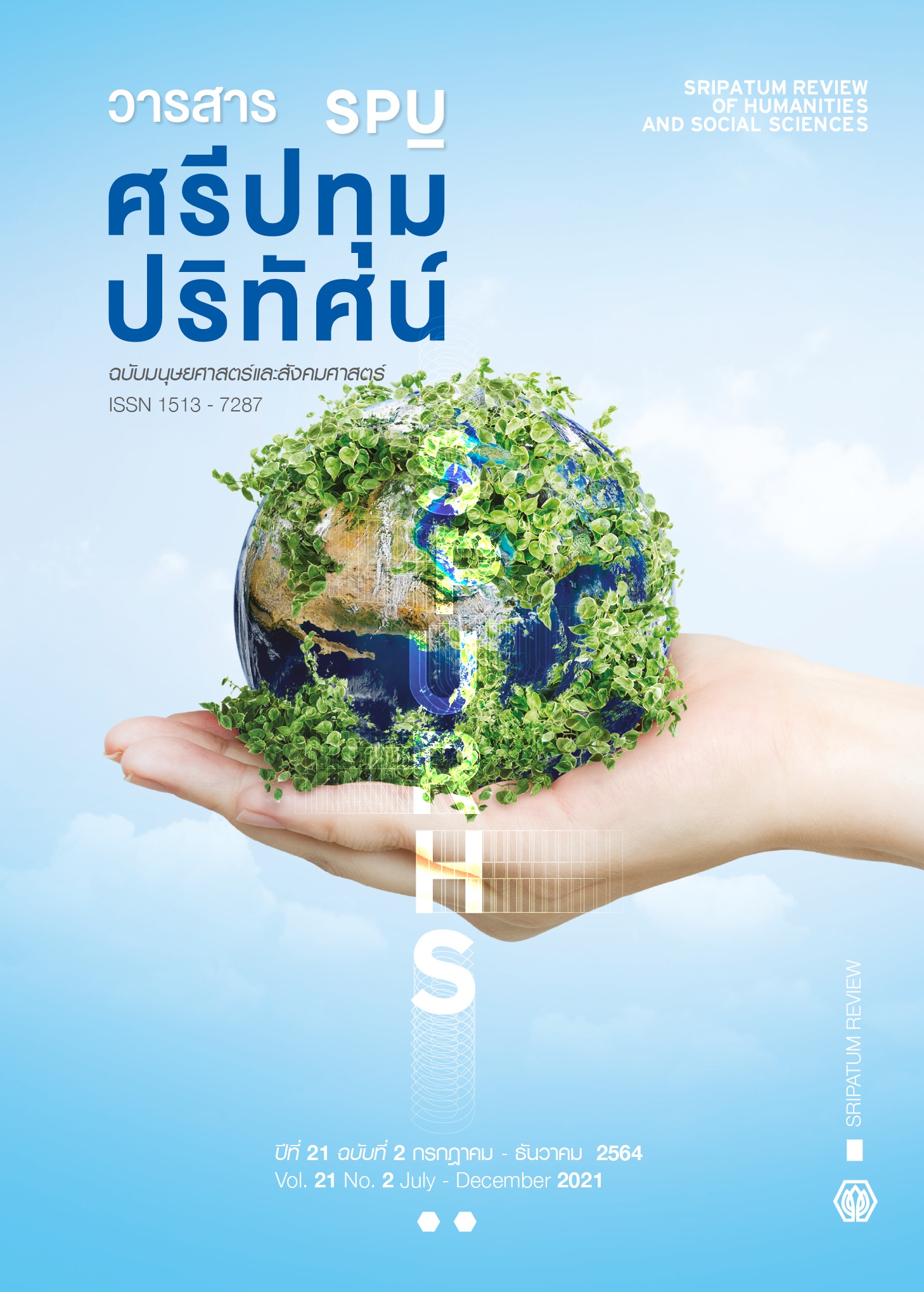An Adaptation of Culture and Beliefs in Isan Society
Main Article Content
Abstract
This research was a part of the research entitled Isan Buddhism: Adaptation amid Diversity of Beliefs in the Contexts of Isan Society. Its purpose was to study the cultural adaptation amid diversity of beliefs in Isan society. Research data were collected from 4 provinces in Northeastern Thailand. Research tools consisting of an interview form and an observation form were used to collect data from 36 target group persons. The research data were analyzed and presented by descriptive analysis. The research results revealed that Isan society had five worldviews of beliefs, namely, the belief in spirits or animism, Brahmanism, Buddhism, Christianity and Islam. Amidst these five beliefs, Isan people had adapted themselves by using the animism belief as a tool for creating the insurance on agricultural security and various welfares in life. When Brahmanism had spread to this region, Isan people perceived it as a religion of the elite class, but had adapted this belief into the belief of spirits, in order to confirm and assure the existence of spirits called “Kwan”. Nonetheless, when Buddhism, which is highly flexible, had spread to this region, Isan people accepted it and mixed it with local beliefs to become Buddhism for local people that integrated both animism and Brahmanism. Later, when Christianity had been introduced under a nation-state mechanism, religious violence had occurred as a result. Notwithstanding, Isan local cultures had adapted well by adhering to the kinship system which was the cultural foundation for holding together the relationship of coexistence in the society. When Islam, which has highly unique identity, had spread to this region, the Isan people who were flexible had accepted Muslims as a group of people who came to fulfill the Isan food culture of beef consumption. Such condition enabled Isan people to adapt themselves to coexist well with various groups of people with beliefs and cultural diversity.
Article Details
1. กองบรรณาธิการสงวนสิทธิ์ในการพิจารณาและตัดสินการตีพิมพ์บทความในวารสาร
2. บทความทุกเรื่องจะได้รับการตรวจสอบทางวิชาการโดยผู้ทรงคุณวุฒิ แต่ข้อความและเนื้อหาในบทความที่ตีพิมพ์เป็นความรับผิดชอบของผู้เขียนแต่เพียงผู้เดียว มิใช่ความคิดเห็นและความรับผิดชอบของมหาวิทยาลัยศรีปทุม
3. การคัดลอกอ้างอิงต้องดำเนินการตามการปฏิบัติในหมู่นักวิชาการโดยทั่วไป และสอดคล้องกับกฎหมายที่เกี่ยวข้อง
References
Annals. Part 39. Archives of Wan Valit. Commemorative cremation ceremony of Phongthong Thongchuea, 5 September, 1964. (in Thai)
Bayet, G. (1984). History of religious propagation in Isan and Laos. Michael Kien Smerphitak Translated. N.p. (in Thai)
Boonchai, P. and Chantachon, S. (1997). Buddhism, Status, Role in Change in Isan Society. Mahasarakham: The Research Institute of Northeastern and Culture, Maha Sarakham University. (in Thai)
Chuchuay, W. (1990). Muslim society in Isan. Thesis of the Degree of Master of Art Program in Thaikadee Studies. Mahasarakham: Maha Sarakham University. (in Thai)
Diller, A. (2002). National Identity and Its Defenders: Thailand Today. Chiang Mai: Silkworm books.
Duangmala, C. (2016). Modification of religious words of northeastern Christians Case Study Bansongyae Kham Toei Subdistrict, Thaicharoen District, Yasothon Province. Thesis of the Degree of Master of Art Program in Thai language. Mahasarakham: Mahasarakham University. (in Thai)
Higham, C. and Thosarat, R. (2012). Early Thailand from Prehistory to Sukhothai. Bangkok: River books.
Kirsch, A. Thomus. (1976). Phu Thai Religious Syncretism: A Case study of Thai Religion and Society. Thesis of the Degree of Doctor of Philosophy Program in Anthropology. Cambridge: Harvard University.
Meethaisong, T. (2017). Ghost and Buddhism, integration of beliefs. Bangkok: Intanin. (in Thai)
Polnamin, R. (2009). Christianity and social and cultural change to develop the quality of life For sustainable life in Isan communities. Thesis of the Degree of Doctor of Philosophy Program in Cultural Studies. Mahasarakham: Mahasarakham University. (in Thai)
Rittidet, P. (2007). Adaptation of a farmer community in Tung Kula Ronghai Area. Thesis of The Degree of Doctor of Philosophy Program in Tai Studies. Mahasarakham: Mahasarakham University. (in Thai)
Samuttakup, S. (2000). Cultural politics and the secularization of the Bun Phawes in Roi-et Market Town. Anthropological Collection on Isan Society and Culture. Nakhon Ratchasima: Northeastern Anthropology Museum Project, School of Social Technology Technology Suranaree University. (in Thai)
Samuttakup, S. and Kitiarsa, P. (2001). Heet Ban Kong Muang: Anthropological Collection on Isan Society and Culture. Nakhon Ratchasima: Northeastern Anthropology Museum Project, School of Social Technology, Technology Suranaree University. (in Thai)
Sanlabkum, P. (2005). Adaptation for live together of Buddhists and Christians: A case study of Ban Khok Klang, Ban Dong Khi Nak, Ban Non Malee, Pha Nam Yoi Sub-district, Nong Phok District, Roi Et Province. Thesis of the Degree of Master of Art Program in Thai Studies. Mahasarakham : Mahasarakham University. (in Thai)
Siam almanac. (1987). Bangkok: Siambun. (in Thai)
Sommot Amarabhanhu, K. K. (1965). Announcement of the Royal Ceremony, Book 1. Bangkok: Kurusabha. (in Thai)
Stuart-Fox, M. (2013). History of Laos (Translated by Winyarat, J. and others). 2nd ed. Bangkok: Toyota Thailand Foundation. (in Thai)
Tanabe, S. (1993). Sacrifice and Buddhist Discourse: The Pu Sae Ya Sae Spirit Cult of Northern Thailand, in S. Tanabe (ed.) Anthropology of Practical Religion: The World of Theravada Buddhism, Kyoto: Kyoto University Press.
Terwiel, B.J. (2001). Monks and Magic an Analysis of Religious Ceremonies in Central Thailand. Bangkok: White Lotus.
Vachirapanno, D. (2012). Buddhism in Laos. 2nd ed. Bangkok: Medchai Printing. (in Thai)
Wongsawat, C. (2016). Creating Identities of Ban Songkhon Christian in Isan. Thesis of Degree of the Doctor of Philosophy Program in Tai Studies. Mahasarakham: Mahasarakham University.(in Thai)
Wallipodom, S. (1990). Isan Civilization Basin: Archaeological and Historical Evidence. Bangkok: Matichon. (in Thai)


